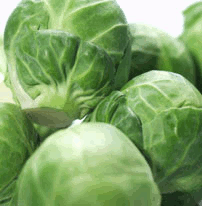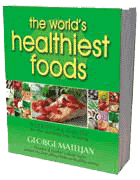Brassica Family Foods Turn On Genes that Prevent Cancer
Broccoli and other brassica family vegetables, such as Brussels sprouts, kale and cabbage, are well known for their high concentration of a compound called sulforaphane, which has significant cancer- and chemo-protective properties. Now, a paper in the September 15, 2002 issue of Cancer Research has provided insight into how sulforaphane helps rid the body of carcinogens and other toxic chemicals by stimulating the expression of genes that encode a wide array of protective antioxidant and detoxification enzymes.
Practical Tips
Want your health-promoting genes to express themselves? Give them the nutritional support they need by making Brassica family foods frequent contributors to your healthy way of eating. Here are a few of the World's Healthiest Foods quick serving ideas to help:
- Top your salads with a tablespoon or two of broccoli sprouts.
- Combine quartered cooked Brussels sprouts with sliced red onions, walnuts and some crumbled feta cheese, then marinate in olive oil and balsamic vinegar.
- For an easy, healthy version of stuffed cabbage, spoon some leftovers such as rice salad or cooked veggies onto the center of a cabbage leaf. Roll into a neat little package and bake in medium heat oven until hot.
- Toss chopped kale, pine nuts and gorgonzola cheese with freshly cooked whole grain pasta drizzled with olive oil.
To learn more about the amazing health benefits of these Brassica family of vegetables, truly some of the World's Healthiest Foods, click broccoli, Brussels sprouts, cabbage, or kale.
For some truly exceptional recipes that will help you make these crucifers a staple in your healthy way of eating, take a look at the World's Healthiest Foods' Recipes containing of these foods. Simply, click on the Recipe Assistant, select the foods for which you'd like some recipes from the Healthy Foods List, and click on the Submit button. A list containing links to all our recipes containing the foods chosen will appear immediately below.
Research Summary
Brassica vegetables' sulforaphane works its protective magic by altering gene expression for numerous genes that are themselves regulated by nuclear factor E2 p-45-related factor 2 (Nrf2)-a genetic factor that encodes for enzymes responsible for eliminating carcinogens and other toxicants inside cells. This was discovered by research groups from the Bloomberg School of Public Health at John Hopkins University and Tsukuba University in Japan who used a gene chip ( Murine Genome U74Av2 oligonucleotide array) that represents 6000 well-understood genes along with 6,000 expressed sequence tags. This allowed them to follow the complex interactions among thousands of proteins from a whole genome instead of just one gene at a time. By comparing gene expression changes between different groups of mice with normal Nrf2 and mice specially bred to lack this nuclear factor, Dr. Shyam Biswal and his team analyzed the downstream genomic targets of Nrf2, which research has already established is activated by sulforaphane.
The targets of Nrf2 were found to be genes for a number of protective enzymes including those for NAD(P)H quinone reductase, glutathione-s-transferase, glutamylcysteine synthetase, NADPH regenerating enzymes, various xenobiotic metabolising enzymes and biosynthetic enzymes of the glutathione and glucuronidation liver detoxification pathways. These latest research findings confirm the importance of Brassica vegetables in the biochemistry of cancer chemoprotection.
Reference: Thimmulappa RK, Mai KH, Srisuma S, Kensler TW, Yamamoto M, Biswal S. Identification of Nrf2-regulated Genes Induced by the Chemopreventive Agent Sulforaphane by Oligonucleotide Microarray. Cancer Res 2002 Sep 15;62(18):5196-5203.






